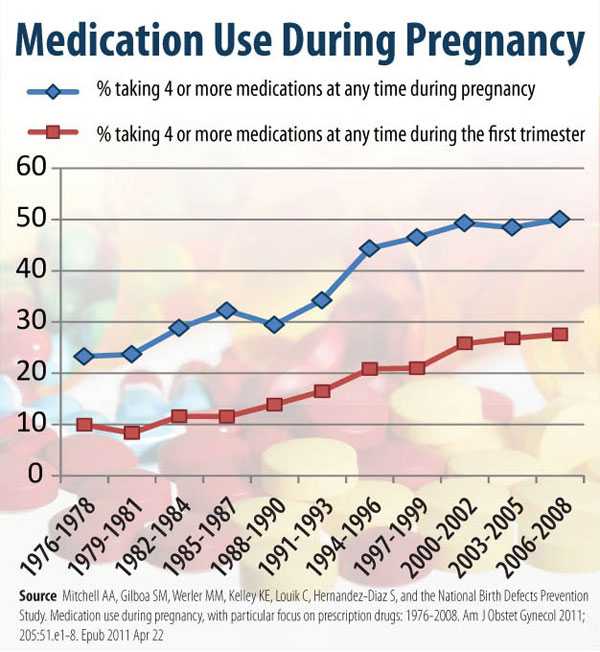Data and Statistics

Pregnant woman with medication.
CDC’s research shows that use of medication during pregnancy is common and increasing over time. Click on the “Read Summary” links to learn more about each study.
Use of Medication in Pregnancy
- A 2011 study using U.S. data from 1976-2008 reported that most women (about 90%) take at least one medication during pregnancy and 70% take at least one prescription medication.
- Over the last 30 years,
- First trimester use of prescription medications has increased more than 60%
- First trimester use of 4 or more medications nearly tripled and use of 4 or more medications anytime during pregnancy more than doubled
[Read summary]
Over-the-Counter Medications
- A 2005 study reported that most women take non-prescription, sometimes called over-the-counter (OTC), medications at some point during pregnancy:
- Acetaminophen, commonly used for pain relief, was used by about 65% of pregnant women.
- Ibuprofen, another common pain reliever, was used by about 18% of women during pregnancy.
- Pseudoephedrine, a decongestant, was used by about 15% of pregnant women.
[Read summary]
Antidepressant Medications
- In a study of pregnancies between 1998–2005, 4.5% of women reported using an antidepressant (frequently used to treat depression or anxiety) 3 months before becoming pregnant or during the pregnancy.
- Use of selective serotonin-reuptake inhibitors (SSRIs) was reported most often (3.8%), followed by bupropion [Wellbutrin®] (0.7%).
- There was a decline (3.1% to 2.3%) in reported use of antidepressants between the first and second month after conception, which appears to be related to the time women find out they are pregnant.
- Data from four states showed that the frequency of reported antidepressant use during pregnancy increased from 2.5% in 1998 to 8.1% in 2005.
[Read summary]
- A recent study of pregnant and nonpregnant women 18-44 years old (from 2005-2009) showed that half of pregnant and nonpregnant women with depression received treatment with prescription medication as the most common form of treatment.
[Read summary]
Herbal Products
- In a study of pregnancies between 1998–2004, 10.9% of women reported using an herbal product (not including prenatal vitamins) 3 months before becoming pregnant or during pregnancy.
- During pregnancy, prevalence was 9.4%, and use was highest in the first trimester.
- Higher prevalence was associated with age greater than 30 years and greater than a high school education.
- Ginger and ephedra were the most commonly reported herbal products used early in pregnancy; use of teas and chamomile were commonly reported throughout pregnancy.
[Read summary]
Antibiotic Medications
- In a study of U.S. pregnancies between 1997–2003, 29.7% of women reported using antibiotics 3 months before becoming pregnant or while pregnant.
- Two percent of women reported antibiotic use 3 months before becoming pregnant.
- Antibiotic use increased during pregnancy, peaking at 5.8% during the fourth month.
- Penicillins were the most frequently reported antibiotics, used by 5.9% of pregnant women.
[Read summary]
Highlighted Articles
Key Findings: Use of Pain Medicine During Early Pregnancy May Be Related To Birth Defects
A study from the Centers for Disease Control and Prevention (CDC) found that women who took NSAIDs and opioid pain medicines during early pregnancy were more likely to have babies affected with certain birth defects compared with women who took acetaminophen.
Key Findings: Antidepressant Prescription Claims among Reproductive-aged Women
CDC’s Morbidity and Mortality Weekly Report published a new study looking at how often women aged 15-44 years filled a prescription for an antidepressant medication.
Key Findings: Assessing YouTube Videos for Content on Medication Use during Pregnancy
The journal Pharmacoepidemiology and Drug Safety published a new study looking at the content of YouTube videos.
Key Findings: A Closer Look at the Link Between Specific SSRIs and Birth Defects
New CDC study findings refute some earlier reported links but confirm other links observed between birth defects and some selective serotonin reuptake inhibitors (SSRIs), which are medications used to treat depression and other mental health conditions.
Key Findings: Opioid Use among Women Aged 15-44
CDC researchers found that during 2008–2012, on average, 28% of women aged 15-44 years with private health insurance and 39% of women with Medicaid filled a prescription written by a healthcare provider for an opioid medication.
Key Findings: Opioid use and neural tube defects
The journal Obstetrics and Gynecology has published a new study that looked at the use of opioids during pregnancy and their relationship to having a pregnancy affected by a neural tube defect (NTD).
Key Findings: How much do we know about the most common medicines used during pregnancy?
In a new CDC study, researchers identified the medicines most commonly used by women during the first trimester (first three months) of pregnancy. They also looked at the gaps in information about the safety or risk of using these medicines during pregnancy.
Key Findings: Safe lists for medications in pregnancy- inadequate evidence base and inconsistent guidance from web-based information, 2011
A brief report looked at information and guidance on the internet about the safety of using medications during pregnancy.
Key Findings: Use of topiramate in pregnancy and risk of oral clefts
A new study looked at the risk of oral clefts among babies born to mothers who reported use of topiramate during the first trimester of pregnancy.
Maternal Treatment with Opioid Analgesics and Risk for Birth Defects
Opioid analgesics are prescription medications that commonly are used to treat severe pain. Two common opioid medications are codeine and oxycodone. Lower doses of opioids also might be included in some cough medicines. The effects of opioids on a pregnant woman and her unborn baby are not well understood.
Influencing Clinical Practice Regarding the Use of Antiepileptic Medications During Pregnancy
An introductory editorial article co-written by a CDC author is also in the special issue of this journal. This article gives a brief historical overview of the study of birth defects. It also highlights emerging topics that are discussed in the special issue.
Safe Medication Use During Pregnancy
Talk with your doctor if you are pregnant.
(Published: May 5, 2016)
- Page last reviewed: March 28, 2017
- Page last updated: August 18, 2016
- Content source:



 ShareCompartir
ShareCompartir